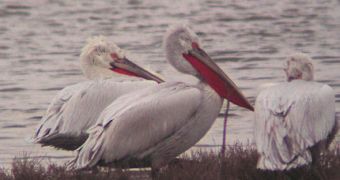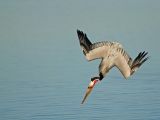Pelicans look like birds hailing from prehistoric times. Truth is, they are precisely that. These birds are believed to have appeared 100 Ma ago, during the dinosaur era, and it is said they reached their peak of diversity 65-57 Ma ago, when about 57 species roamed the Earth. Today, only 8 species of pelicans can be found around the world. 30 Ma ago, giant pelicans, larger than the modern ones, existed.
1. For long, pelicans were believed to be related to cormorants, frigatebirds, darters, tropicbirds and boobies, based on the fact that these are the only birds to have a foot membrane encasing all the four toes.
Yet DNA analysis had a few huge surprises in store: not only are pelicans not related with these birds, even remotely, but they are closely related to storks and herons and - here was the big shock - their closest relative proved to be the odd shoebill (Balaeniceps rex)!
2. The largest pelican is the Dalmatian pelican: 1.8 m (6 ft) long, weighing up to 15 kg (33 lbs) and having a wingspan of over 3 m (10 ft). Despite their large size, pelicans are relatively light because of their pneumatic bones: the skeleton makes for less than 10% of their weight. This is the reason why pelicans cannot dive.
The smallest pelican is the spot-billed pelican (P philipinensis) from Asia - it is 1.5 m (5 ft) long and weighs only about 5 kg (11 pounds).
3. The pelicans are most known for their skin sac attached to the lower jaw that they use when they're fishing. The bill is about 50 cm (1.6 ft) long and the upper jaw finishes in a hook employed for harpooning the captured fish. Because the bill is rather heavy, pelicans fly with their necks bended. The hook can tear the gular pouch of other pelicans. The gular pouch also has the role of stimulating the young to eat and is used in thermo-regulation: during periods of extreme heat, the pelican flutters it to lose heat, the same way in which African elephants use their ears.
When fishing, the gular pouch can hold a water volume heavier than the bird itself (up to 20-22 liters). One of the most spectacular fishing methods is when the birds fly in circle above shallow waters. By means of repeated wing beatings, they gather the fish to the center of the circle which is gradually tightened. Meanwhile, the pelicans move their heads in semicircle with the bill wide open. The slightest touch of a fish makes the bill to close up.
4. Pelicans eat about 0.9-1.2 kg (2-3 pounds) of fish daily; when one of these birds is also raising youngsters, the daily amount of consumed fish can increase to 4 kg (18 pounds). Pelicans form nurseries, similar to the ones encountered in flamingos and penguins. They can swallow fish weighing up to 1.85 kg (4.1 pounds). Pelicans can fly up to 200 km (120 mi) daily, from their colonies to the feeding areas.
Because pelican excrements are acid, they destroy the reed beds or the trees around, and pelican colonies must be relocated once every couple of years. 5. Only the brown pelicans of the Americas live at sea and dive for fish. These birds launch themselves from heights of 20 m (66 ft), at a speed of 65 km (41 mi) per hour, but because of their relatively low weight, they cannot submerge more than 2 m (6.6 ft).

 14 DAY TRIAL //
14 DAY TRIAL // 
